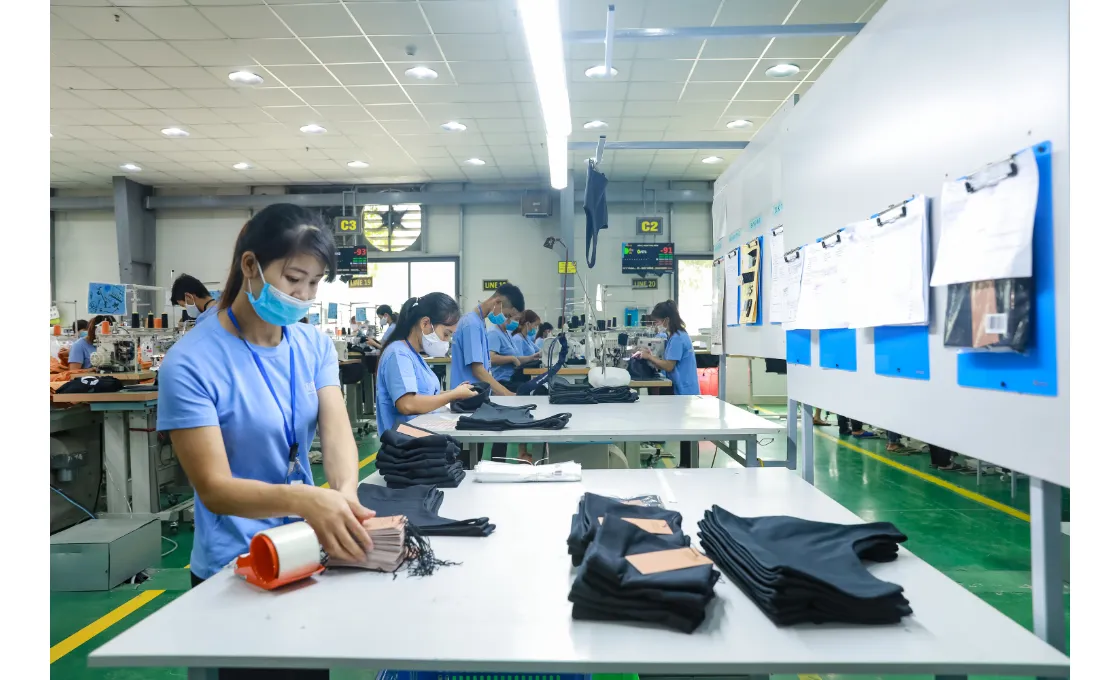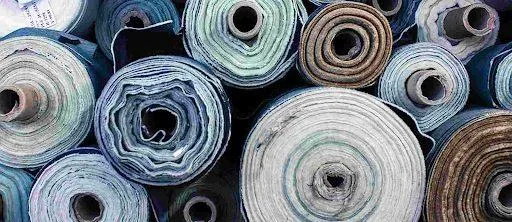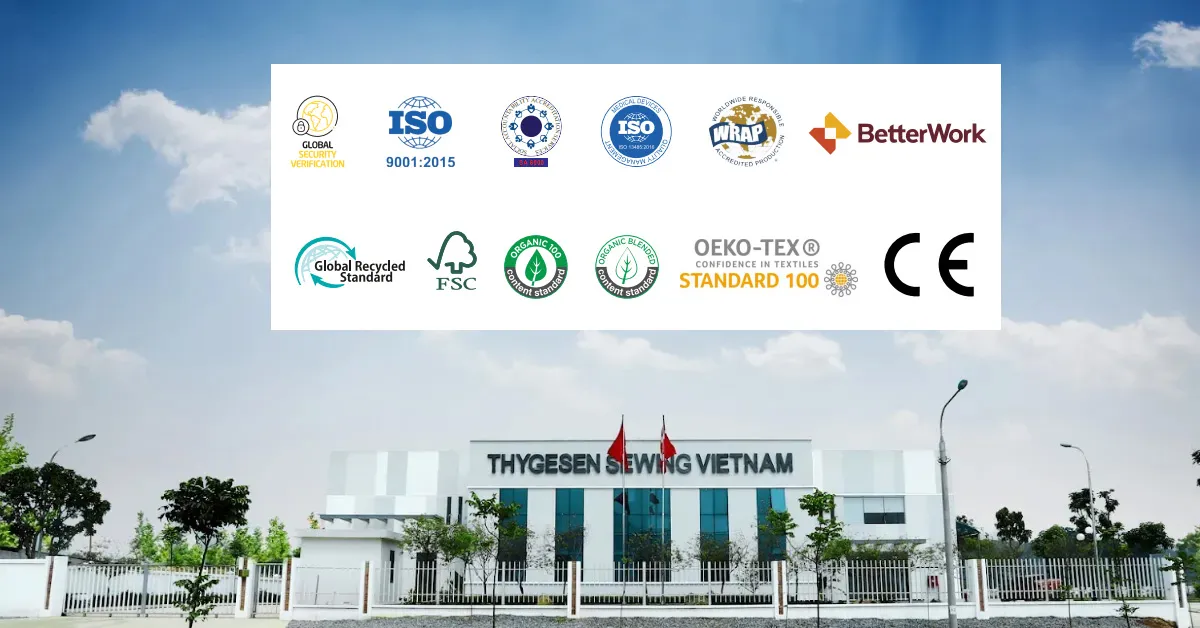As one of the leading knitted fabric & garment manufacturers in the North of Vietnam, Thygesen Textile Vietnam deeply understands both advantages and disadvantages of a typical Vietnam garment factory.

Why Should You Work With Vietnam’s Clothing Manufacturers?
Large labor force at low cost
Garment manufacturing is one of the most popular industries in Vietnam, with a really good craftsmanship & affordable labor. In fact, about 2.5 millions Vietnamese people are working in this industry, the majority of who are experienced workers.
Many people are very willing to work as garment manufacturing workers at basic wages. Compared to China, Vietnamese labor cost in the garment industry is relatively lower. That’s why a lot of garment factories have moved from China to Vietnam recently.
In recent years, the fabric & garment manufacturing industry has accounted for about 20% of Vietnam’s GDP. Aiming to build up an export-oriented economy, the Vietnamese government at the same time invested in developing high quality and skillful labor force for this industry. In practice, technicians university graduates in Vietnam are qualified enough to deal with every technical requirement in this industry. Therefore, it can be seen that the labor force is actually an advantage of any Vietnam garment factory.
Government incentives
As mentioned above, the Government of Vietnam is trying its best to support the garment manufacturers. Manufacturers who locate their factories in poor areas and create jobs for local residents will receive big tax incentives and favorable conditions like tax exemption, tax reduction, or tax payment extension…
In addition, local administrators help enterprises connect with organizations and associations that can help them to promote their business. The administrative procedures are also simplified thoroughly to save enterprises’ time and effort. There is no obstacle but encouragement to become a Vietnam garment factory in both economic and administrative perspectives.
Besides, the Vietnamese government accompanies foreign investors, as evidenced by Foreign direct investment (FDI). According to the United Nations Conference on Trade and Development (UNCTAD), Vietnam received FDI capital of up to US$1.55 billion for 184 garment and textile projects in the first 11 months of 2019. Due to government incentives, major economic hubs that attracted the most FDI in 2019 include:
- the Southern and Central parts of Vietnam, Tay Ninh (US$464 million, 16 projects),
- Quang Nam (US$107 million, 10 projects),
- Nghe An (US$210 million, 3 projects),
- Thua Thien Hue (213 million, 2 projects).
Beneficial FTAs

Vietnam now has important Free Trade Agreements and Strategic Partnership Agreement with almost all main garment markets like the USA, EU, Japan, Korea, Australia… Garment products, which are of Vietnam origin will benefit from low or even zero importing tariff while it’s normally about 10-20%.
The garment and textile industries benefit from increased market access through free trade agreements (FTAs) and technological advancements. Vietnam’s bilateral and multilateral FTAs continue to provide new markets for Vietnamese businesses, reducing the impact of rising trade protectionism. These include:
- Comprehensive and Progressive Agreement for Trans-Pacific Partnership (CPTPP),
- Vietnam-EU Free Trade Agreement (EVFTA),
- Regional Comprehensive Economic Partnership (RCEP)
- UK-Vietnam FTA (UKVFTA)
Another advantage Vietnam garment factories will have is that Vietnam is a member of the ASEAN economic community – ACE which has signed FTAs with Australia, New Zealand, Korea, China so that garments made of ASEAN origin materials can be treated with importing tax incentives as if they are of Vietnam origin.
For importing inputs during manufacturing, Thailand has developed a strong industry of manufacturing high-quality fabric and accessories especially they are able to supply for even small orders. This is also a big help for Vietnam garment factories in terms of importing tariffs.
In addition to reducing tariff barriers, FTAs also reduce non-tariff barriers. Vietnam garment factories gain a big opportunity to access new bigger markets. FTAs also create a strong media effect as customers from member countries will also gain benefits from those FTAs.
Therefore, Vietnam garment factories have an opportunity to stabilize their productions and develop as well as challenge themselves with new obstacles, especially higher requirements from their new customers.
Logistics system
Transportation infrastructure in Vietnam for the garment manufacturing industry is quite developed. Almost all basic logistics services from sea transportation, internal transportation, customer clearance, warehouses…are available here in Vietnam.
From a logistics perspective, there is no limitation for materials from other countries to come to Vietnam, and cargo from Vietnam goes to other markets. International express shipping service is also available here. In the garment manufacturing industry, sample development is very important. Garment samples should be transferred across countries in the fastest way. International express shipping service is essential in this case. Information logistics is also an advantage of Vietnam as the internet is also very popular here.
Reliability

Compared to other countries, Vietnam is considered a trustworthy partner in international trade relationships. Vietnam companies are also trustworthy partners in international business relationships too. They bet their reputation on their customer’s trust.
As Vietnam is a very stable country, there is no risk of politics, law, wars.. or any similar risk. Vietnam laws are also quite friendly with international trade law and business law. There is not too much difference or conflicts between Vietnam laws and international trade law. The Government does not protect companies who have intended to cheat their foreign customers so that those kinds of risks are not much.
Many of Vietnam’s garment factory. in Vietnam are perfect themselves to meet well with international quality and manufacturing standards. They know that they need to build their reputation and gain their customers’ trust right from their capacity.
Capacity
Vietnam garment companies know how to perfect their capability to be able to meet well with customer’s requirements. Although most Vietnam garment factories are small and medium manufacturers, they still can carry out big orders or provide OEM/ODM services for manufacturing garment products.
Garment factories in Vietnam build very close-knit cooperating relationships together to have a stronger manufacturing capacity. Not many garment factories in Vietnam have printing or embroidery systems of machines in their house. They choose to cooperate with a professional printing or embroidery service supplier instead to save their capacity from expensive investment.
Possible Limitations Of Working With A Vietnam Garment Manufacturer
Designing
Designing is a big disadvantage of Vietnam garment factory. For many years, the garment manufacturing industry in Vietnam focused on outsourcing orders or CM or CMPT services. The Design stage was not included in Vietnam garment factories’ service. Among so many reasons which lead to that practice, the lack of talented designers is the main one. There is neither a professional education nor training academy nor a business environment for garment designing. The lack of professional garment designers in Vietnam is also understandable.

Vietnam garment factories don’t have good international business and marketing knowledge as well as experience. This is also a typical weak point of Vietnam enterprises. Not many Vietnam garment factories develop their own collection, promote and distribute for their own brand. Therefore, most of them do not really have a demand for designing. Or almost all of them don’t want to pursue such risky projects. They are too busy with outsourcing orders.
However, it’s not absolutely that there is not any Vietnam garment factory as in-house designers. ONE-STOP-SHOP service suppliers often have talented designers. They are able to help their customers bring raw ideas of garment products to life in a very delighted look while their designs are still very friendly with the industrial manufacturing environment. They also have solid knowledge and experience with materials. They know exactly which is the best kind of material for a specific design with desired properties.
Marketing
As mentioned above, marketing is the Achilles heel of Vietnam garment factories. They are mainly focused on a very narrow stage of the global value chain – CM or CMPT or FOB. Most of them do not have enough capacity to carry out full professional marketing campaigns for their own branded products. Therefore, the knowledge about the market and consumers is very limited and, of course, they don’t have their potential distribution channel for those products too.
Customer service
The customer service’s quality depends a lot on its supplier capability and orientation. This is also Vietnam garment companies’ weakness. Only a few Vietnam garment factories invest in a professional sales team who has both technical knowledge of the garment industry and business experience as well as necessary skills.
You also need to seek deeply to find Vietnamese garment factories that have adequate knowledge of the foreign market & work directly with foreign customers. Fortunately, e-commerce has re-defined how the world implements marketing campaigns. This’s a rare opportunity for Vietnam garment factories to take off.
Sourcing

The lack of knowledge about international trade makes Vietnam garment factories not really good at sourcing input materials.
People may argue that it’s not too hard nowadays to find a good supplier for any kind of material. Yes. They are right. But many Vietnam garment factories do not want to risk their finance on input materials. Both 2 those reasons make Vietnam garment factories not really good at sourcing. That makes them find it difficult in providing their customers with a full-package garment manufacturing service.
Certificate of Origin
The majority of materials used by a typical Vietnam garment factory is of China origin while additional value created by their outsourcing service is relatively low. Consequently, lots of Vietnam garment factories are struggling with the localization of their supplies in order to benefit from FTAs. However, the supporting industry is developing quite fast in Vietnam, opening a bright future for the garment manufacturing industry.
Thygesen Textile Vietnam – Reliable Vietnam Garment Factory Providing OEM/ODM Service

Among so many Vietnam garment factories, Thygesen Textile Vietnam is considered a leading knitted fabric and garment manufacturer in the North of Vietnam. Starting in Denmark in 1931 and placing its first factory in Vietnam in 2004,
Thygesen Textile Vietnam is now the best investment from Denmark into Vietnam. We are now providing ODM/OEM for manufacturing almost any kind of high functional knitted garment from Activewear, Workwear to Kidswear, Underwear, Hospitalwear, casual fashion, and bandage.
Thygesen owns a modern factory located in Phu Tho province where an abundant labor force is available at a very low cost. Being the first investor in that area and creating many new jobs, we benefit a lot from tax incentives and favorable conditions.
You can see our sewing factory & the typical manufacturing process here:
We focus on training our labor very well to master all modest machines equipped in a LEAN system in our factory as well as to be experts in garment techniques. We do everything to assure that all of our garment products must be produced at the highest level of quality.
We make all of our quality control systems, as well as materials & completed product tests, comply with international standards like OEKO-TEX, ISO… We inspect 100% of materials before manufacturing and have in-line Q/C to prevent every technical issue from arising.
We built up professional teams for each stage of manufacturing from Marketing, sales, designers & sample developer, technicians, sourcing, merchandiser, logistics… For decades working with so many customers across the globe, we are confident to be capable and experienced enough to provide a flexible and adaptive one-stop-shop service that can meet well with all of the customers’ requirements.
Backed with a close-knit relationship with a broad network of material suppliers and subcontractors, Thygesen Textile Vietnam is totally free in helping its customers develop new kinds of materials and samples as well as deal with special requirements.
Our vision is to satisfy our customers with the best quality products and supportive service at the most reasonable cost and shortest lead-time.















